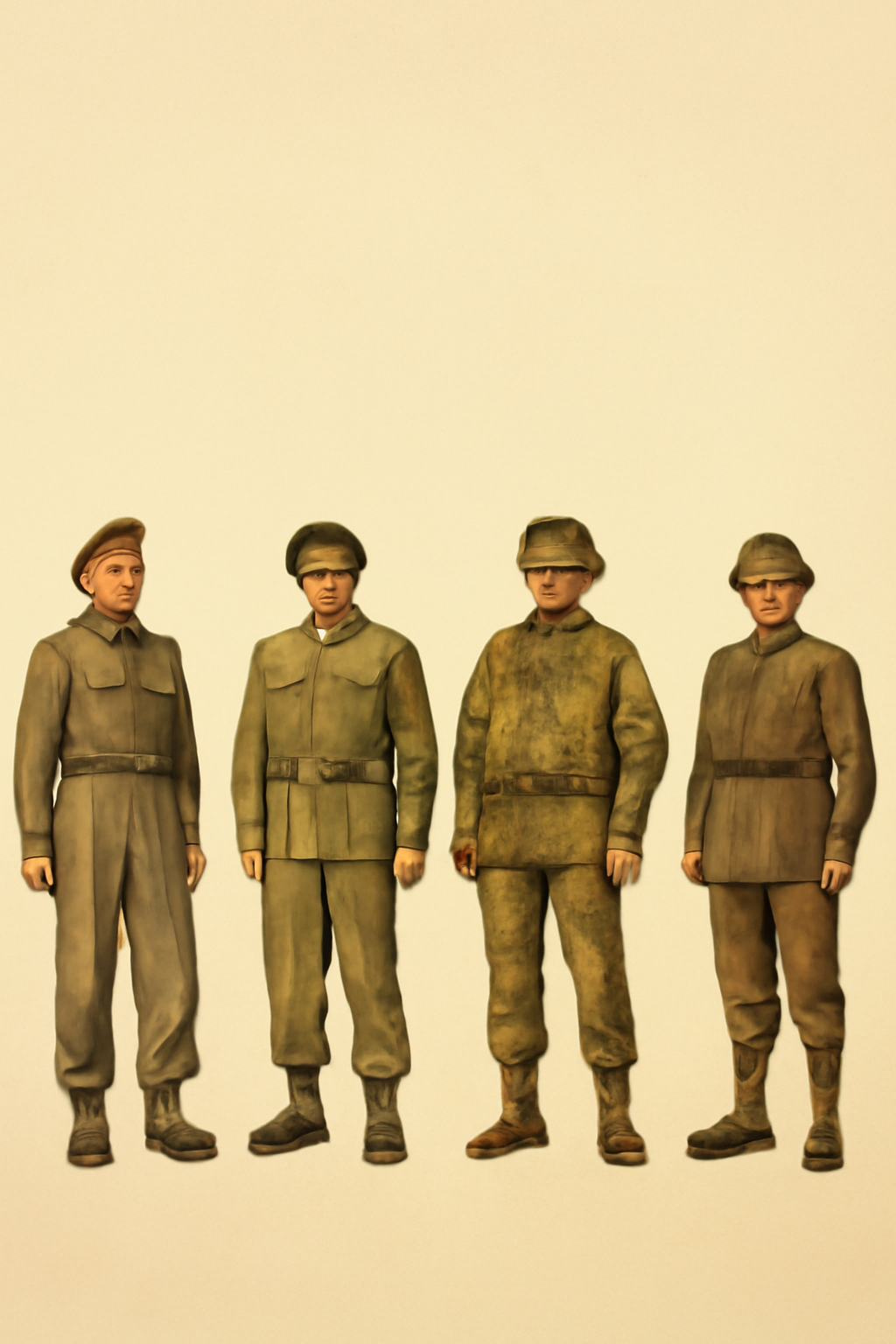
Discover the Different Types of WWII British Uniforms: Royal Army Jackets, Helmets & More
Published on Jun 12, 2025
WWII British Uniform Types: A Complete Guide to Royal Army Jackets, Helmets & More
When we think of World War II, images of bravery, resilience, and strategic warfare come to mind. However, another vital element often overlooked is the uniform — a soldier's armour, identity, and source of pride. The WWII British uniform types were designed not just for function but to embody discipline, tradition, and unity. Whether it's the classic Royal Army jacket or the reliable British military helmet, each piece tells a story of valour and tactical brilliance.
Understanding the Structure of WWII British Uniforms
During the Second World War, British soldiers wore a variety of uniforms based on their rank, role, and branch of service. Uniforms were not only tailored for comfort and mobility but also for camouflage and protection against harsh European climates.
The core components of a standard British soldier's uniform during WWII included:
- Battle Dress Blouse (Royal Army Jacket)
- Battle Dress Trousers
- 1937 Pattern Web Equipment
- British Military Helmet (Mk II or Mk III)
- Boots, ankle or ammunition boots
- Puttees or gaiters
Let's take a closer look at these WWII British uniform types and how they varied among regiments and special units.
1. The Royal Army Jacket – Backbone of British Military Wear
One of the most recognizable elements of the WWII British uniform is the Royal Army jacket — officially known as the Battle Dress Blouse. Introduced in 1937, this wool serge jacket became the standard field wear for British and Commonwealth troops.
Key Features:
- Short-cut and form-fitting to reduce snagging and increase mobility.
- Pleated breast pockets for utility.
- Buttoned front with concealed buttons to avoid catching on equipment.
- Epaulettes for attaching rank insignia.
The jacket was durable and relatively warm, making it ideal for combat in the temperate climates of Europe. Officers often had tailored versions with finer materials.
SEO Tip: If you're a reenactor or collector, the Royal Army jacket is one of the most sought-after items due to its authentic design and historical significance.
2. British Military Helmet – Protection & Identity
Another standout feature in the British WWII ensemble was the British military helmet, typically either the Mk II or Mk III. These helmets played a dual role — offering ballistic protection and symbolizing the identity of the British fighting forces.
Mk II Helmet:
- Inspired by the World War I Brodie helmet.
- Made of manganese steel with a wide brim.
- Often painted in matte olive drab to reduce visibility.
Mk III Helmet (Introduced in 1944):
- Known as the "Turtle Helmet" due to its shape.
- Offered better coverage for the neck and sides.
- Primarily issued during the Normandy invasion and afterwards.
Helmets were often fitted with netting to reduce glare and to allow camouflage foliage.
3. Battle Dress Trousers and Footwear
Complementing the Royal Army jacket, the battle dress trousers were made from the same wool serge material. They featured:
- Large map pocket on the leg.
- Reinforced seat and knees.
- Buttoned fly and suspenders for support.
Footwear included ammunition boots made of blackened leather with steel toe caps. Soldiers wore puttees or gaiters to protect the ankles and shins.
4. Specialist Uniform Variants
Beyond the standard infantry, many WWII British units had unique uniform adaptations. These included:
Paratroopers:
- Denison smock (camouflage top worn over battle dress).
- Jump boots with reinforced soles.
Tank Crews:
- Black wool overalls.
- Padded helmets for protection inside cramped tanks.
Desert Units (Eighth Army):
- Khaki Drill uniforms.
- Slouch hats or pith helmets for sun protection.
Each variation of the WWII British uniform was engineered to serve the needs of the environment and mission.
5. Connection to Napoleonic British Uniforms
The British Army has a long and storied tradition of military dress. While Napoleonic British uniforms from the early 19th century were vastly different in style — featuring bright red coats, tall shakos, and elaborate gold braids — echoes of this heritage persisted.
For instance, many WWII regiments retained historic badges and buttons, linking them to their past glories. Understanding Napoleonic British uniforms provides insight into how tradition influenced even the functional designs of the 1940s.
6. Insignia, Rank, and Regimental Distinctions
British uniforms in WWII weren't just functional — they were also rich in detail. Shoulder flashes, divisional insignias, and regimental patches were often sewn onto the uniform sleeves to indicate:
- Branch (infantry, engineers, medical corps, etc.)
- Division (e.g., 1st Armoured Division)
- National origin (Canada, Australia, India, etc.)
These details made the uniform a personalized representation of a soldier's role and achievements.
7. The Importance of Authentic Reproduction
Whether you're a film customer, historical educator, or military enthusiast, authenticity matters. At Paddelaters.com, we offer historically accurate reproductions of WWII British uniform types — from Royal Army jackets to British military helmets — meticulously crafted to match wartime originals.
Why This History Still Matters
Understanding WWII British uniforms isn't just about clothing — it's about connecting with a crucial period in global history. These uniforms tell stories of ordinary men who stood firm against tyranny, fighting for freedom in one of the darkest chapters of the 20th century.
Whether you're collecting, researching, or reenacting, each piece carries the legacy of resilience and sacrifice.
Final Thoughts
From the Royal Army jacket to the unmistakable British military helmet, the WWII British uniform types represent more than just fabric and metal. They are emblems of courage, discipline, and tradition.
As interest in WWII history grows among educators, collectors, and reenactors, understanding these uniforms becomes even more essential. Explore our full collection at Paddelaters.com to own a piece of history today.
Looking for authentic WWII gear?
Explore our collection of WWII British uniforms, Napoleonic British uniforms, Royal Army jackets, and British military helmets — all designed with precision and historical accuracy.
